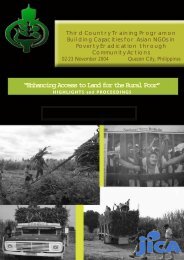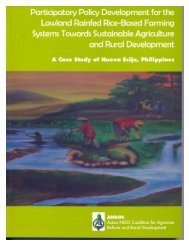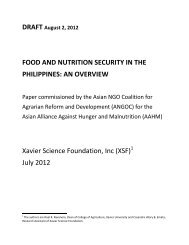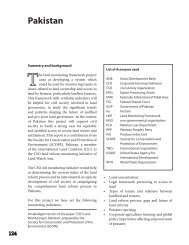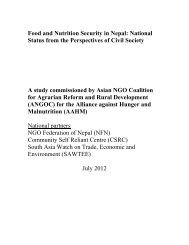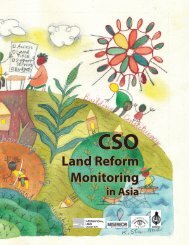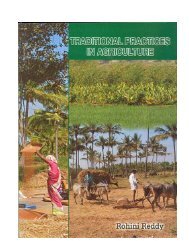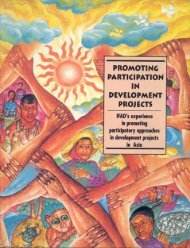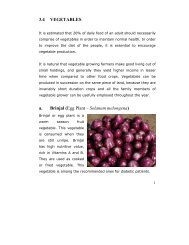Securing the Right to Land FULL - ANGOC
Securing the Right to Land FULL - ANGOC
Securing the Right to Land FULL - ANGOC
Create successful ePaper yourself
Turn your PDF publications into a flip-book with our unique Google optimized e-Paper software.
NEPAL<br />
Overview of Access <strong>to</strong> <strong>Land</strong><br />
<strong>Land</strong> Tenure System<br />
The system of land tenure in Nepal has evolved in<strong>to</strong> various forms<br />
and phases over <strong>the</strong> years. His<strong>to</strong>rically, state ownership was <strong>the</strong><br />
traditional form of land tenure in Nepal. The land belonged <strong>to</strong> <strong>the</strong><br />
State and its rulers. After 1946, six major types of land tenure<br />
were recognized; <strong>the</strong>se are Raikar, Birta, Jagir, Rakam, Kipat and<br />
Guthi (Tuladhar, 2005). Today, however, only two types of tenure<br />
prevail: Raikar and Guthi.<br />
Raikar<br />
The term Raikar is probably derived from <strong>the</strong> Sanskrit words<br />
Rajya (state) and Kara (tax), thus denoting land on which <strong>the</strong><br />
state levies taxes. This is what distinguishes Raikar from o<strong>the</strong>r<br />
forms of land tenure, such as Birta, Guthi, and Kipat, where <strong>the</strong><br />
occupant does not necessarily pay taxes and is generally not<br />
listed in official records.<br />
Under this tenure system, <strong>the</strong> tenants have <strong>to</strong> pay a yearly<br />
land tax <strong>to</strong> <strong>the</strong> Government for cultivating <strong>the</strong> land. The tax<br />
used <strong>to</strong> be paid through local agents (called Jimidar, Talukdar,<br />
QUICK FACTS<br />
ASSERTING FREEDOM FROM CENTRAL CONTROL<br />
111<br />
➤ Nepal’s <strong>to</strong>tal land area is 147,181 square<br />
kilometers. Only 20% of this is cultivable.<br />
➤ According <strong>to</strong> <strong>the</strong> 2001–2002 agricultural census:<br />
➲ 94.1% of holdings is agricultural land, covering<br />
24.98 million hectares. The remaining land<br />
(156,400 hectares) is non-agricultural;<br />
➲ Forested/woodland areas have been reduced<br />
from 108.8 thousand hectares in 1991–1992<br />
<strong>to</strong> 37,200 hectares in 2001–2002—a decrease<br />
of 71,600 hectares, or 66%, during <strong>the</strong> 10year<br />
period.<br />
➲ Some 20–25% of cultivable land is left fallow<br />
because of land ownership disputes.<br />
Jimwal, or Mukhiya) of government. The agents also used <strong>to</strong><br />
perform <strong>the</strong> task of land administration—and, in fact, acted as<br />
landlords—for which <strong>the</strong>y retained a certain percentage of <strong>the</strong><br />
collected land tax as <strong>the</strong>ir fee/salary. Numerous cases of exploitation<br />
of tenants were reported during <strong>the</strong> administration<br />
of <strong>the</strong>se local agents. The system of collecting land tax by appointing<br />
local agents was abolished by <strong>the</strong> <strong>Land</strong> Act 2020 (1964).<br />
The Raikar system was adopted at a time when <strong>the</strong> supply of land<br />
in <strong>the</strong> country far exceeded <strong>the</strong> demand for it. In fact, <strong>the</strong> law (<strong>the</strong><br />
Nepal Muluki Ain) which instituted <strong>the</strong> Raikar system visualized<br />
land as a free commodity <strong>to</strong> be distributed among <strong>the</strong> local inhabitants<br />
on <strong>the</strong> basis of <strong>the</strong>ir need and on <strong>the</strong> availability of land.<br />
<strong>Right</strong>s <strong>to</strong> Raikar land are limited <strong>to</strong> occupancy rights vis-à-vis<br />
<strong>the</strong> state. These rights can be freely sold or transferred <strong>to</strong> any<br />
person; in practice, it is almost like ownership. The term used<br />
for Raikar transactions is “Rajinama,” literally “resignation,” or<br />
giving up <strong>the</strong> right <strong>to</strong> land.<br />
Ninety-eight (98) percent of Nepali farmland currently operates<br />
under <strong>the</strong> Raikar tenure system.<br />
ASIAN NGO COALITION FOR AGRARIAN REFORM AND RURAL DEVELOPMENT



